air condition BUICK TERRAZA 2007 Owner's Manual
[x] Cancel search | Manufacturer: BUICK, Model Year: 2007, Model line: TERRAZA, Model: BUICK TERRAZA 2007Pages: 562, PDF Size: 2.96 MB
Page 60 of 562
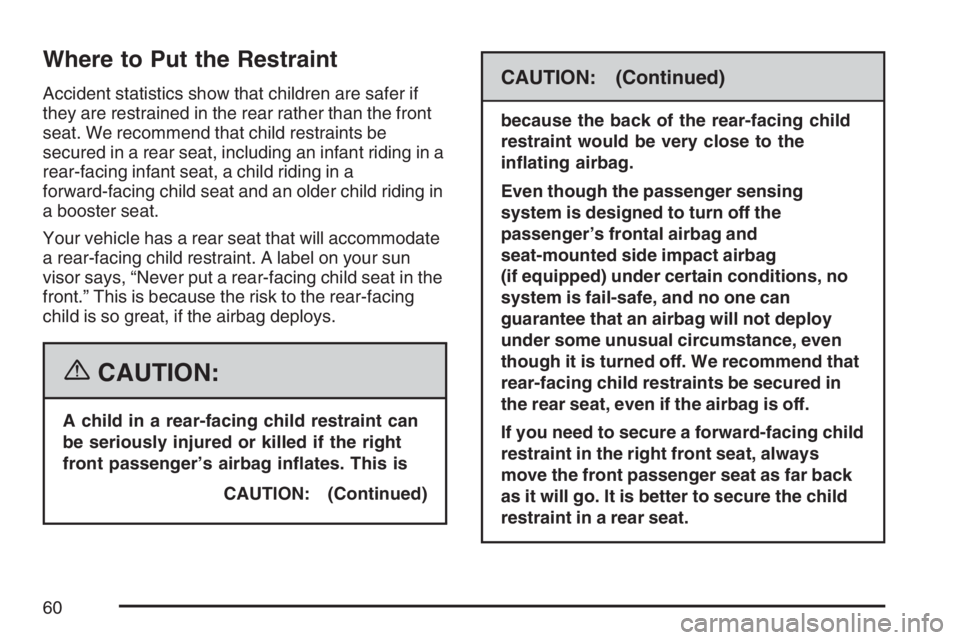
Where to Put the Restraint
Accident statistics show that children are safer if
they are restrained in the rear rather than the front
seat. We recommend that child restraints be
secured in a rear seat, including an infant riding in a
rear-facing infant seat, a child riding in a
forward-facing child seat and an older child riding in
a booster seat.
Your vehicle has a rear seat that will accommodate
a rear-facing child restraint. A label on your sun
visor says, “Never put a rear-facing child seat in the
front.” This is because the risk to the rear-facing
child is so great, if the airbag deploys.
{CAUTION:
A child in a rear-facing child restraint can
be seriously injured or killed if the right
front passenger’s airbag in�ates. This is
CAUTION: (Continued)
CAUTION: (Continued)
because the back of the rear-facing child
restraint would be very close to the
in�ating airbag.
Even though the passenger sensing
system is designed to turn off the
passenger’s frontal airbag and
seat-mounted side impact airbag
(if equipped) under certain conditions, no
system is fail-safe, and no one can
guarantee that an airbag will not deploy
under some unusual circumstance, even
though it is turned off. We recommend that
rear-facing child restraints be secured in
the rear seat, even if the airbag is off.
If you need to secure a forward-facing child
restraint in the right front seat, always
move the front passenger seat as far back
as it will go. It is better to secure the child
restraint in a rear seat.
60
Page 72 of 562
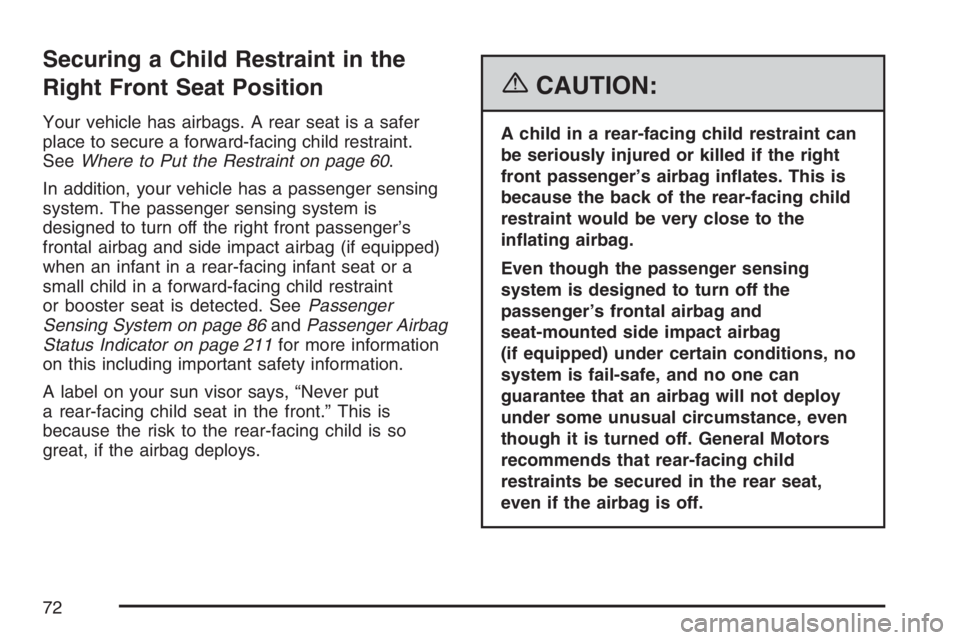
Securing a Child Restraint in the
Right Front Seat Position
Your vehicle has airbags. A rear seat is a safer
place to secure a forward-facing child restraint.
SeeWhere to Put the Restraint on page 60.
In addition, your vehicle has a passenger sensing
system. The passenger sensing system is
designed to turn off the right front passenger’s
frontal airbag and side impact airbag (if equipped)
when an infant in a rear-facing infant seat or a
small child in a forward-facing child restraint
or booster seat is detected. SeePassenger
Sensing System on page 86andPassenger Airbag
Status Indicator on page 211for more information
on this including important safety information.
A label on your sun visor says, “Never put
a rear-facing child seat in the front.” This is
because the risk to the rear-facing child is so
great, if the airbag deploys.
{CAUTION:
A child in a rear-facing child restraint can
be seriously injured or killed if the right
front passenger’s airbag in�ates. This is
because the back of the rear-facing child
restraint would be very close to the
in�ating airbag.
Even though the passenger sensing
system is designed to turn off the
passenger’s frontal airbag and
seat-mounted side impact airbag
(if equipped) under certain conditions, no
system is fail-safe, and no one can
guarantee that an airbag will not deploy
under some unusual circumstance, even
though it is turned off. General Motors
recommends that rear-facing child
restraints be secured in the rear seat,
even if the airbag is off.
72
Page 86 of 562
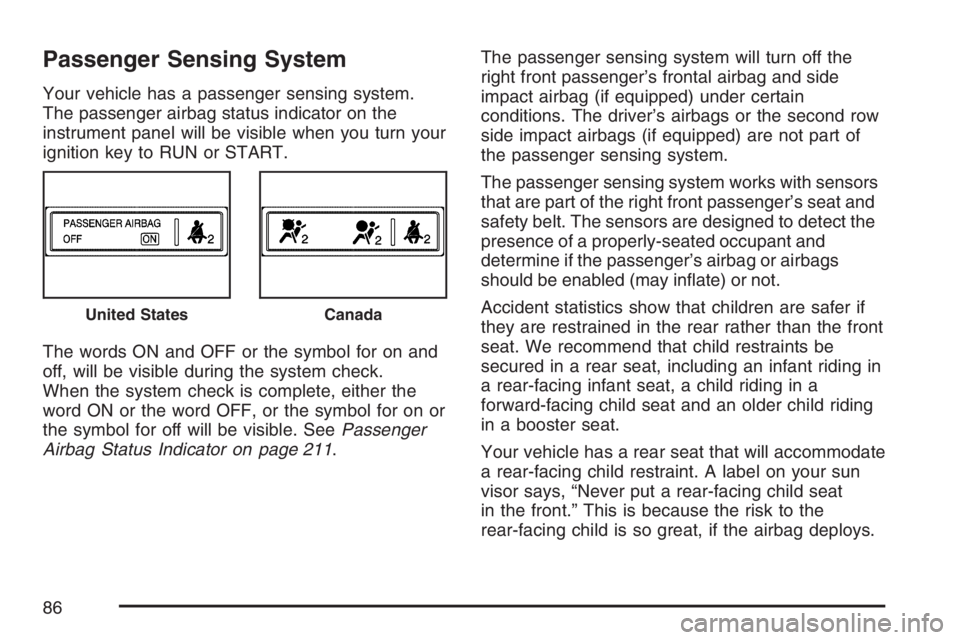
Passenger Sensing System
Your vehicle has a passenger sensing system.
The passenger airbag status indicator on the
instrument panel will be visible when you turn your
ignition key to RUN or START.
The words ON and OFF or the symbol for on and
off, will be visible during the system check.
When the system check is complete, either the
word ON or the word OFF, or the symbol for on or
the symbol for off will be visible. SeePassenger
Airbag Status Indicator on page 211.The passenger sensing system will turn off the
right front passenger’s frontal airbag and side
impact airbag (if equipped) under certain
conditions. The driver’s airbags or the second row
side impact airbags (if equipped) are not part of
the passenger sensing system.
The passenger sensing system works with sensors
that are part of the right front passenger’s seat and
safety belt. The sensors are designed to detect the
presence of a properly-seated occupant and
determine if the passenger’s airbag or airbags
should be enabled (may in�ate) or not.
Accident statistics show that children are safer if
they are restrained in the rear rather than the front
seat. We recommend that child restraints be
secured in a rear seat, including an infant riding in
a rear-facing infant seat, a child riding in a
forward-facing child seat and an older child riding
in a booster seat.
Your vehicle has a rear seat that will accommodate
a rear-facing child restraint. A label on your sun
visor says, “Never put a rear-facing child seat
in the front.” This is because the risk to the
rear-facing child is so great, if the airbag deploys.
United StatesCanada
86
Page 87 of 562

{CAUTION:
A child in a rear-facing child restraint can
be seriously injured or killed if the right
front passenger’s airbag in�ates. This is
because the back of the rear-facing child
restraint would be very close to the
in�ating airbag.
Even though the passenger sensing
system is designed to turn off the
passenger’s frontal airbag and
seat-mounted side impact airbag
(if equipped) under certain conditions,
CAUTION: (Continued)
CAUTION: (Continued)
no system is fail-safe, and no one can
guarantee that an airbag will not deploy
under some unusual circumstance, even
though it is turned off. We recommend
that rear-facing child restraints be secured
in the rear seat, even if the airbag is off.
If you need to secure a forward-facing
child restraint in the right front seat,
always move the front passenger seat as
far back as it will go. It is better to secure
the child restraint in a rear seat.
87
Page 145 of 562
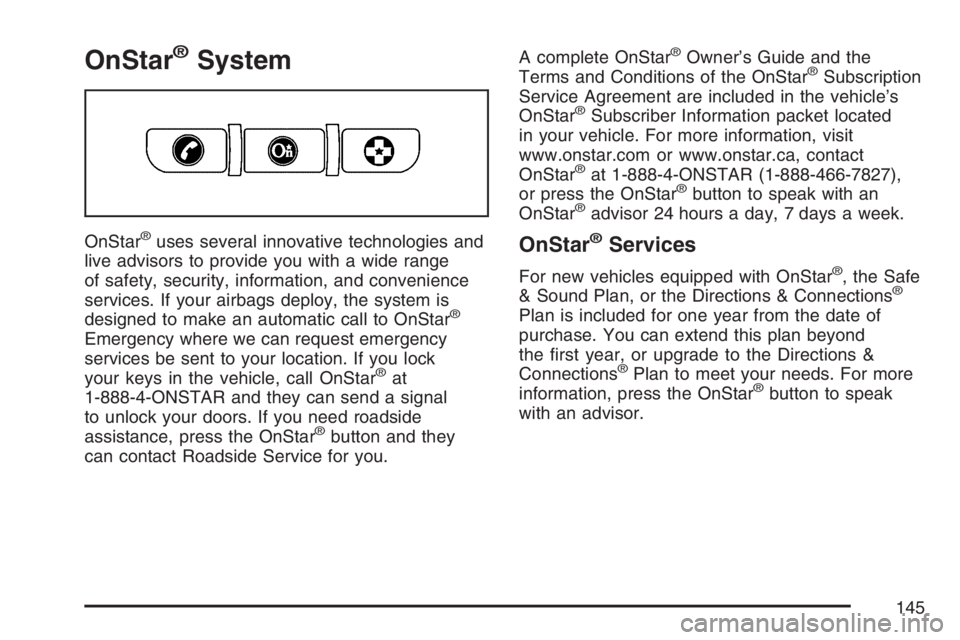
OnStar®System
OnStar®uses several innovative technologies and
live advisors to provide you with a wide range
of safety, security, information, and convenience
services. If your airbags deploy, the system is
designed to make an automatic call to OnStar
®
Emergency where we can request emergency
services be sent to your location. If you lock
your keys in the vehicle, call OnStar
®at
1-888-4-ONSTAR and they can send a signal
to unlock your doors. If you need roadside
assistance, press the OnStar
®button and they
can contact Roadside Service for you.A complete OnStar
®Owner’s Guide and the
Terms and Conditions of the OnStar®Subscription
Service Agreement are included in the vehicle’s
OnStar
®Subscriber Information packet located
in your vehicle. For more information, visit
www.onstar.com or www.onstar.ca, contact
OnStar
®at 1-888-4-ONSTAR (1-888-466-7827),
or press the OnStar®button to speak with an
OnStar®advisor 24 hours a day, 7 days a week.
OnStar®Services
For new vehicles equipped with OnStar®, the Safe
& Sound Plan, or the Directions & Connections®
Plan is included for one year from the date of
purchase. You can extend this plan beyond
the �rst year, or upgrade to the Directions &
Connections
®Plan to meet your needs. For more
information, press the OnStar®button to speak
with an advisor.
145
Page 190 of 562

How the System Works
Unless disabled, the URPA will turn on
automatically when the shift lever is moved into
REVERSE (R). When the system turns on, the
three lights on the display will illuminate for one and
a half seconds to let you know that the system is
working. If your vehicle is moving in REVERSE (R)
at a speed greater than 3 mph (5 km/h), the red
light will �ash to remind you that the system does
not work at speed greater than 3 mph (5 km/h).
If an object is detected at a REVERSE (R) speed
of less than 3 mph (5 km/h), one of the following
will occur:
Description English Metric
amber light 5 ft 1.5 m
amber/amber lights 40 in 1.0 m
amber/amber/red lights &
continuous chime20 in 0.5 m
amber/amber/
red lights �ashing &
continuous chime1 ft 0.3 m
A chime will sound the �rst time an object
is detected between 20 inches (0.5 m) and
5 feet (1.5 m) away.URPA cannot detect objects that are above liftgate
level. In order for the rear sensors to recognize
an object, it must be within detection range behind
the vehicle.
When the System Does Not Seem to
Work Properly
The light may �ash red when the vehicle is in
REVERSE (R) if the ultrasonic sensors are
not kept clean. So be sure to keep your rear
bumper free of mud, dirt, snow, ice and slush.
Other conditions that may affect system
performance include things like the vibrations from
a jackhammer or the compression of air brakes
on a very large truck. If after cleaning the
rear bumper and then driving forward at least
15 mph (25 km/h), the display continues to �ash
red, see your dealer.
If a trailer was attached to your vehicle, or a
bicycle or an object was on the back of, or hanging
out of your liftgate during your last drive cycle,
the light may also �ash red. The light will continue
to �ash whenever in REVERSE (R) until your
vehicle is driven forward at least 15 mph (25 km/h)
without any obstructions behind the vehicle.
190
Page 194 of 562
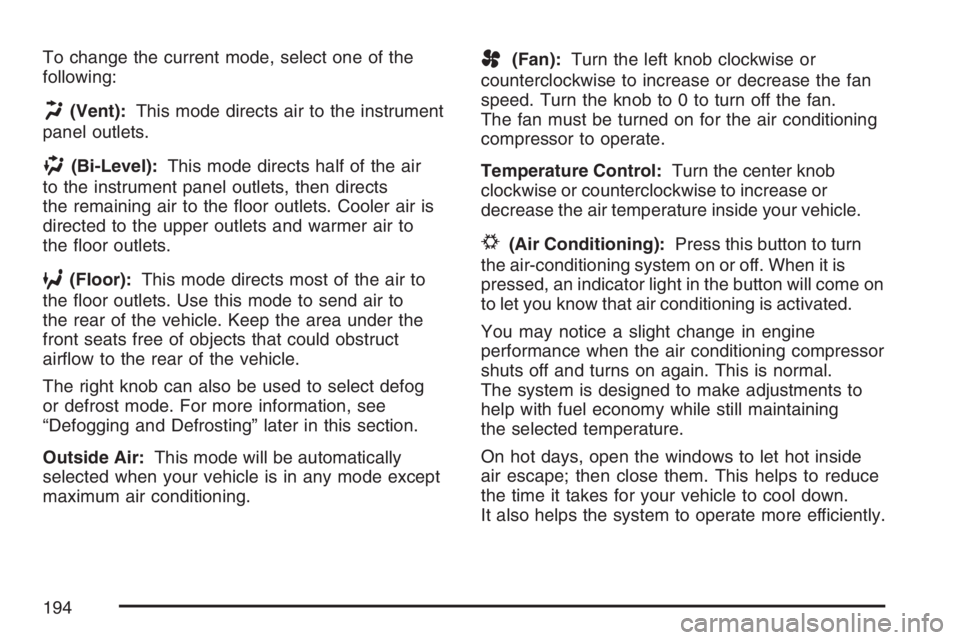
To change the current mode, select one of the
following:
H(Vent):This mode directs air to the instrument
panel outlets.
)(Bi-Level):This mode directs half of the air
to the instrument panel outlets, then directs
the remaining air to the �oor outlets. Cooler air is
directed to the upper outlets and warmer air to
the �oor outlets.
6(Floor):This mode directs most of the air to
the �oor outlets. Use this mode to send air to
the rear of the vehicle. Keep the area under the
front seats free of objects that could obstruct
air�ow to the rear of the vehicle.
The right knob can also be used to select defog
or defrost mode. For more information, see
“Defogging and Defrosting” later in this section.
Outside Air:This mode will be automatically
selected when your vehicle is in any mode except
maximum air conditioning.
A(Fan):Turn the left knob clockwise or
counterclockwise to increase or decrease the fan
speed. Turn the knob to 0 to turn off the fan.
The fan must be turned on for the air conditioning
compressor to operate.
Temperature Control:Turn the center knob
clockwise or counterclockwise to increase or
decrease the air temperature inside your vehicle.
#(Air Conditioning):Press this button to turn
the air-conditioning system on or off. When it is
pressed, an indicator light in the button will come on
to let you know that air conditioning is activated.
You may notice a slight change in engine
performance when the air conditioning compressor
shuts off and turns on again. This is normal.
The system is designed to make adjustments to
help with fuel economy while still maintaining
the selected temperature.
On hot days, open the windows to let hot inside
air escape; then close them. This helps to reduce
the time it takes for your vehicle to cool down.
It also helps the system to operate more efficiently.
194
Page 195 of 562
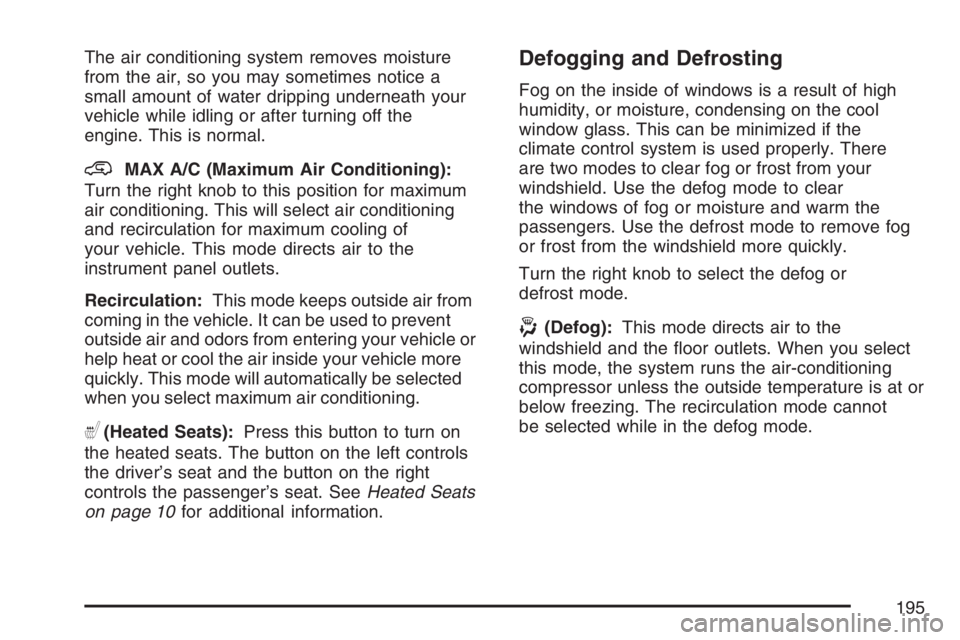
The air conditioning system removes moisture
from the air, so you may sometimes notice a
small amount of water dripping underneath your
vehicle while idling or after turning off the
engine. This is normal.
@MAX A/C (Maximum Air Conditioning):
Turn the right knob to this position for maximum
air conditioning. This will select air conditioning
and recirculation for maximum cooling of
your vehicle. This mode directs air to the
instrument panel outlets.
Recirculation:This mode keeps outside air from
coming in the vehicle. It can be used to prevent
outside air and odors from entering your vehicle or
help heat or cool the air inside your vehicle more
quickly. This mode will automatically be selected
when you select maximum air conditioning.
((Heated Seats):Press this button to turn on
the heated seats. The button on the left controls
the driver’s seat and the button on the right
controls the passenger’s seat. SeeHeated Seats
on page 10for additional information.
Defogging and Defrosting
Fog on the inside of windows is a result of high
humidity, or moisture, condensing on the cool
window glass. This can be minimized if the
climate control system is used properly. There
are two modes to clear fog or frost from your
windshield. Use the defog mode to clear
the windows of fog or moisture and warm the
passengers. Use the defrost mode to remove fog
or frost from the windshield more quickly.
Turn the right knob to select the defog or
defrost mode.
-(Defog):This mode directs air to the
windshield and the �oor outlets. When you select
this mode, the system runs the air-conditioning
compressor unless the outside temperature is at or
below freezing. The recirculation mode cannot
be selected while in the defog mode.
195
Page 196 of 562
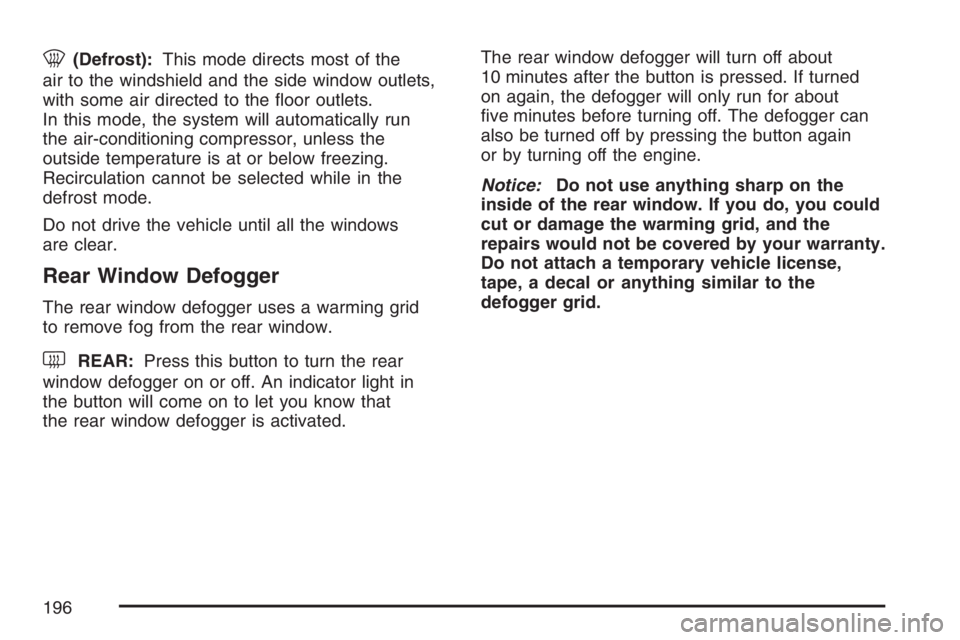
0(Defrost):This mode directs most of the
air to the windshield and the side window outlets,
with some air directed to the �oor outlets.
In this mode, the system will automatically run
the air-conditioning compressor, unless the
outside temperature is at or below freezing.
Recirculation cannot be selected while in the
defrost mode.
Do not drive the vehicle until all the windows
are clear.
Rear Window Defogger
The rear window defogger uses a warming grid
to remove fog from the rear window.
the button will come on to let you know that
the rear window defogger is activated.The rear window defogger will turn off about
10 minutes after the button is pressed. If turned
on again, the defogger will only run for about
�ve minutes before turning off. The defogger can
also be turned off by pressing the button again
or by turning off the engine.
Notice:Do not use anything sharp on the
inside of the rear window. If you do, you could
cut or damage the warming grid, and the
repairs would not be covered by your warranty.
Do not attach a temporary vehicle license,
tape, a decal or anything similar to the
defogger grid.
196
Page 197 of 562

Dual Climate Control System
Your vehicle may have a dual climate control
system. With this system you can control the
heating, cooling, and ventilation for your vehicle.
Operation
9
(Fan):Turn the left knob clockwise or
counterclockwise to increase or decrease the fan
speed. Turn the knob to 0 to turn off the fan.
The fan must be turned on for the air conditioning
compressor to operate.Temperature Control:Use the driver’s and
passenger’s levers to increase or decrease the
air temperature inside your vehicle.
Turn the right knob clockwise or counterclockwise
to direct the air�ow inside of your vehicle.
To change the current mode, select one of the
following:
@MAX A/C (Maximum Air Conditioning):
Turn the right knob to this position for maximum
air conditioning. This will select air conditioning
and recirculation for maximum cooling of
your vehicle.
Recirculation:This mode keeps outside air
from coming in the vehicle. It can be used
to prevent outside air and odors from entering
your vehicle or help heat or cool the air inside
your vehicle more quickly. This mode will
automatically be selected when maximum
air conditioning is selected.
H(Vent):This mode directs air to the
instrument panel outlets.
197